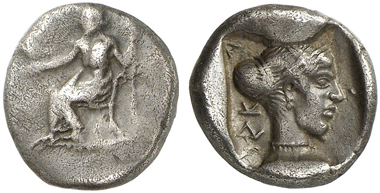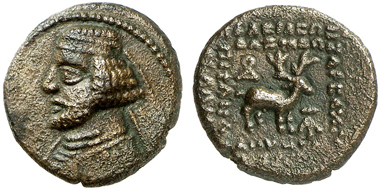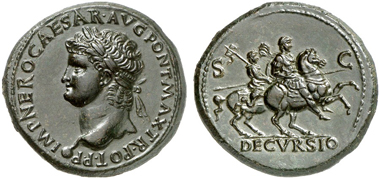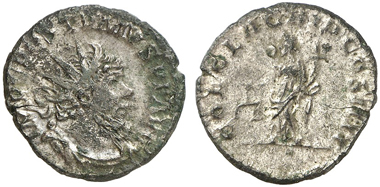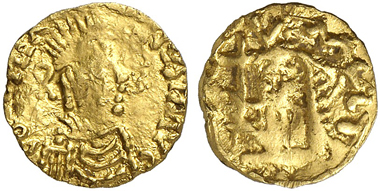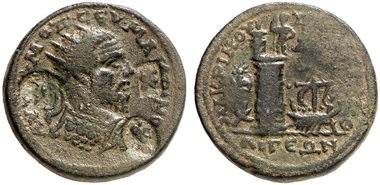12-09-2013 – 01-01-1970
Auction sale 38 – Classical coins and ancient art
Selected coins in Jacquier’s auction sale
On 13th September 2013, auction sale no. 38 will be conducted by Paul-Francis Jacquier. You can participate in this auction live on the internet at www.coinsjacquier.com from 4 p.m. 900 lots will be auctioned off. On offer are ancient coins, objects and numismatic literature.
The sale starts with 18 Celtic and almost 160 Greek coins. As always, the focus is laid on the die cuttings’ quality, a perfect state of preservation and rarity. The label ‘exquisite’ refers to the care with which the selection was assembled together: every single coin has a certain something that makes it stand apart from other items of its emission, be it because of its patina, provenance, style, rarity or historical significance. To really appreciate the offer you just have to take a closer look.
77: Kleitor (Arcadia). Hemidrachm, c. 460-450. Weber 4286 = Williams III, 4, 168d (this specimen). BCD Peloponnesos 1411 (this specimen). From Imhoof-Blumer Coll., Sir Hermann Weber and BCD. Very rare. Finely toned. Very fine. Estimate: 650 euros.
Let us take no. 77 as example, an inconspicuous hemidrachm in very fine. It comes from Arcadia, from the city of Kleitor, to be precise. The obverse depicts Zeus Lykeios, the reverse the nymph Callisto. Admittedly, Kleitor produced no substantial coinage in early classical times, but dies that show the head of Callisto with her hair tied up are definitely scarcer than the ones showing her with hair falling down. At this point, we haven’t even stressed the piece’s eminent provenance: prior to BCD, Dr Friedrich Imhoof-Blumer as well as Sir Hermann Weber owned it.
139: Arsacids. Orodes II, 57-38. Tetrachalkon, Ecbatana. Sellw. 45, 38. Shore 512. Rare. About extremely fine. Estimate: 250 euros.
Naturally, the east is very well represented with Jacquier’s. The offer ranges from the empire of the Seleucids – with the famous tetradrachm of Seleukos I from Susa in about extremely fine – and the Arsacids to the rulers of Persis, Bactria and Arabia, providing the collector with the chance to get pieces here that are generally hard to come by. The selection of Parthian small bronzes in extraordinary states of preservation, in particular, has no peer.
317: Nero, 54-68. Sesterce, Lugdunum, 66. RIC 508. Shiny ink black patina. Extremely fine. Estimate: 20,000 euros.
Speaking of bronzes: what this catalog has to offer in regard to bronze coins from Roman imperial times is truly spectacular. Admirers of a cultivated, untouched patina will be delighted: shiny ink black, black-brown, dark brown with sand coat, orange-brown, dark green, mossy green, sage – you can find every shade! And they come in qualities that aren’t easy to find. Paying a closer look at the Romans will pay off, not only in regard to patina and preservation but, most of all, because of the many small rarities included there. Whether a rare emperor, a rare denomination or a rare coin type – everything is there. And hardly any auction has so many quadrantes assembled in its catalog as this one.
The undisputed star amongst the Roman coins is a sesterce of Nero, struck in Lugdunum in 66. The extremely fine piece with its ink black patina has a magnificent die cutting and shows in every detail the emperor riding a horse and a soldier behind him, likewise riding, with a vexillum shouldered. The splendid specimen has a pre-sale estimate of 20,000 euros.
459: Postumus, 260-269. Antoninianus, Cologne, late in 268. C. 14corr. (150 Fr.!). AGK 3. Elmer 584. Cunetio -. Extremely rare. Very fine. Estimate: 2,500 euros.
Collectors know that at Jacquier’s they can find pieces especially from the 3rd cent. as they seldom show up on the market. The Gallic Empire, as a case in point, is again present with spectacular rarities – how else would you describe an antoninianus stating the Roman name of the city of Cologne in its inscription? Of this extremely rare coin type, only 20 specimens are known to exist, with eight being housed in museums.
644: Merovingians. Cologne, Austrasia. Tremissis, ‘boucle perdue’ type, 560-565/85. Prou 1169. MEC 491. Extremely rare. Only 10 specs. are known to exist of which the one presented here is the only one on the market. Very fine. Estimate: 7,500 euros.
Apropos of Cologne: 7,500 euros is the estimate of a Merovingian tremissis whose obverse refers to Cologne as its place of minting. The coin on offer is only the 10th known specimen and the only one available on the market, for all the others are stored in museums!
231: Aigai (Cilicia). Macrinus, 217-218. Rv. light-house of Aigai, rowboat l. in front, entering harbor. Goat in the field l. SNG France 2344var. SNG Levante 1746var. Three counterstamps on the obverse. Unedited variant of a very rare type. Nice green patina. Very fine. Estimate: 1,500 euros.
And of course the imperial coins from the Greek provinces are present, too, in many unusual, sometimes unedited, specimens. Particularly remarkable is a series from Roman Egypt with rarissima, including a series of nomen coins.
647: Principality of Achaea. Charles I of Anjou, 1275-1285. Corinth(?). Billon denier tournois. Metcalf 948. Very fine. Estimate: 100 euros.
A group of medieval coins from the Crusader states on Greek territory are likely to be a noteworthy addition to the collections of many aficionados of classical Greece. Coins from the Principality of Achaea, the Duchy of Athens and the Despotate of Epirus tell of a time no less thrilling than classical history.
Thirty ancient objects complement the offer. This section’s star is an Attic black-figure lekythos, estimated at 25,000 euros, depicting a fight scene, made around 520 B. C.
An offer of selected literature on ancient numismatics concludes the catalog. As usual, not only books are to be found here, but magnificently bound collector items that will satisfy the bibliophilic reader as well.
The lavishly illustrated catalog can be ordered, with additional 12.50 EUR protective charge, at Paul-Francis Jacquier, Honsellstrasse 8, D-77694 Kehl am Rhein, email.
In order to participate live on the internet please register in time online.
You can have a look at the auction sale catalog on the internet at Sixbid and at Numisbids.




